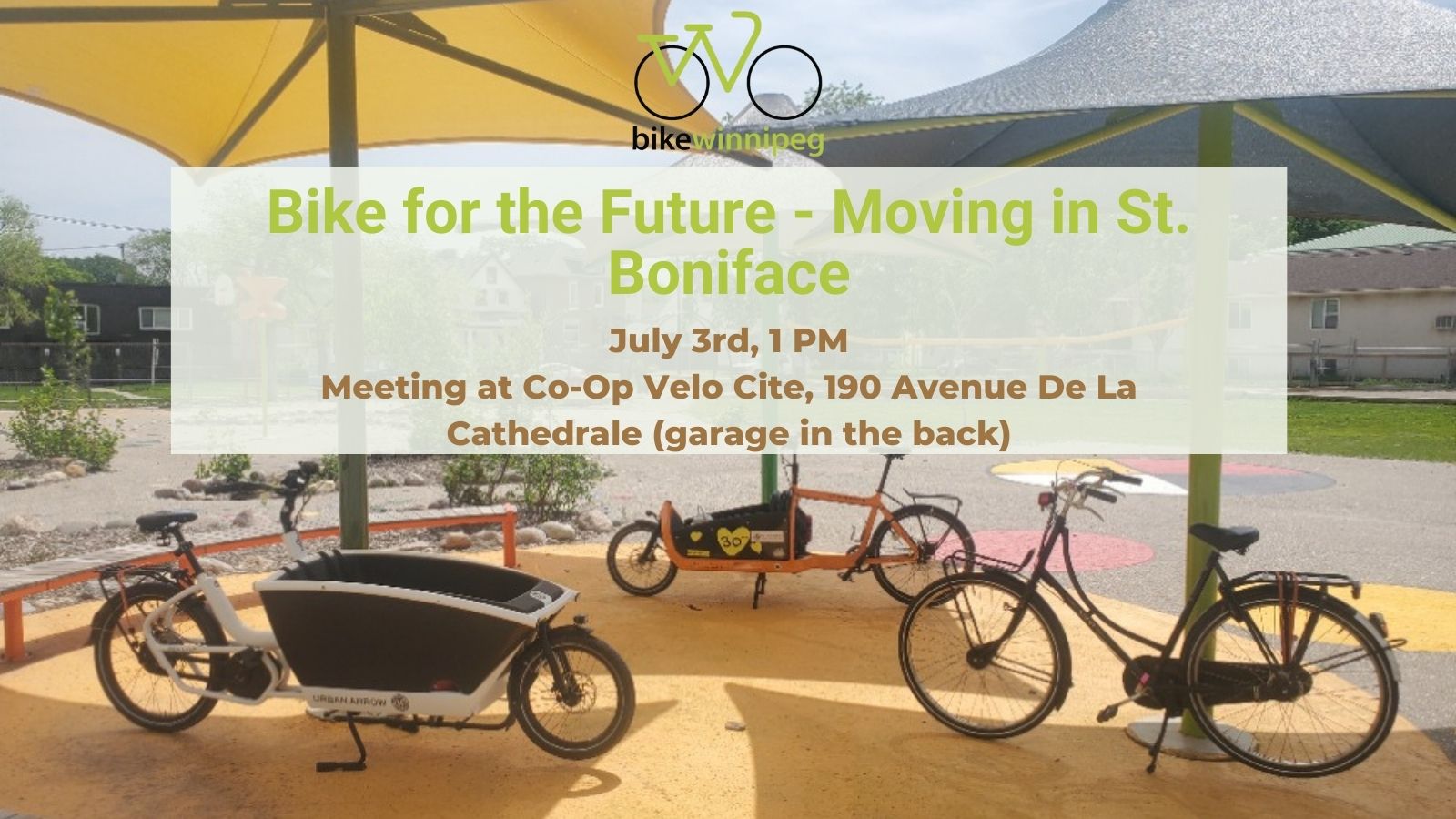Presented by the Bike Winnipeg and Co-Op Velo Cite, this will be a comfortable ride for all ages and abilities leaving from the Co-Op Velo Cite garage we will be touring some of the better streets for riding your bike and highlighting upcoming projects in the area.
When: July 3rd, 1pm
Where: Co-Op Velo Cite, 190 Avenue De La Cathedrale (garage in the back)
Why? Because our climate is warming, and we need our municipal government to build an environment where people can sustainably commute!
What is Bike For the Future?
Bike for the Future was first held in August of 2021 in response to cuts to active transportation funding and the need to create safe speeds for active transportation users in our neighborhoods.
We are a group of concerned citizens advocating for safe spaces for our friends and families to actively commute. Walking and cycling are the two most environmentally friendly modes of transportation and need to play a key role in our greenhouse gas reductions. Transportation makes up 50% of Winnipeg’s emissions (https://winnipeg.ca/sustainability/ClimateChange.stm).
We are in the midst of a climate emergency. Extreme weather events are happening more frequently. Locally we have been suffering through drought which has had an extremely negative impact on farmers and will inevitably raise the cost of putting food on our tables. Air quality warnings became common place in the summer of 2021 as fires raged in northern Manitoba and Ontario. Every day when we turn on our radios and TV’s and hear and see how our global neighbours are suffering from a host of extreme weather events being amplified by anthropogenic climate change. We have had enough foot dragging by all levels of government. They have a responsibility to make walking and riding a bike the easiest way to get around within and between our urban neighborhoods.
In 2019, we proudly watched our youth take to the streets of downtown Winnipeg to demand action on Climate. Many of us marched in solidarity with them. We intend to continue their fight to push all levels of governments to speed up the move to low carbon transportation to help protect their future.
To encourage Winnipeggers to actively commute, they need a transportation system that allows them to safely, comfortably, and conveniently travel from point a to point b, they need access to safe bike storage, and they need affordable access to bicycles. Currently 60% of Winnipeggers feel unsafe walking and cycling. To make it safe and comfortable, motorized vehicles need to drive slowly on our residential roads (no more than 30 km/h). We need separated and protected spaces on routes with higher vehicle speeds and we need plenty of places to safely cross busy streets and rail lines in a reasonable amount of time.
1) We demand that the city start making investments on par with need and non-budget public policy in our cycling and walking strategy. Currently, the City of Winnipeg funds 2 million dollars’ worth of AT projects a year; the city should be spending at least 10 times this amount. It would be reasonable to expect that the cycling network will be completed within the next 10-20 years, not by 2100 at the current pace of budgeting.
2) The city and province need to work out how to lower the default speed limit to 30 km/h immediately. City engineers can set higher speeds on collector and arterial routes where appropriate.
3) The Winnipeg Police need to stop targeting people that ride their bikes on the sidewalks in areas where no safe alternative exists. The problem is not sidewalk riding, the problem is a lack of safe infrastructure for people actively commuting.
4) The city and province need to get a handle on bicycle theft by addressing the root causes of theft. There is an epidemic of bike thefts which discourage people from actively commuting. Providing better mental health supports, living wages and a universal basic income as well as installing more secure solutions for people on bikes could go a long way to reducing bike theft and encourage more people to actively commute.
5) The city needs to look at solutions for areas that are difficult to cross. For example, when the Arlington bridge closes, the distance that someone living on the north or south side of those tracks needed to travel to get somewhere on either side could increase significantly. It would be reasonable to expect the city and the railway company to produce a new crossing or tunnel. Rivers also pose a significant barrier to walking and cycling: the city needs to look at adding more pedestrian and cycling bridges to make cycling between neighborhoods more efficient.
